Quite often how we wake up dictates the rest of our day. If we wake up and everything goes our way, the rest of the day follows right. Starting off with a morning yoga sequence has numerous benefits.
It’s the best way to awaken the mind and brings a vibrancy to the body to set you on a great path for your day. Practicing yoga in the morning will slowly take you from the calm dream-like state to the invigorated and joyful awake state.
“Starting off your day with a morning yoga practice can bring a liveliness to the mind and a vibrancy to the body.”
Read this article to learn:
How To Get Ready For a Morning Yoga Sequence
1. Start the Evening Before
Time is precious, especially in the morning. Since you already get up earlier to make time for your morning yoga practice, you want to make the most of it. You don’t want to spend time to find your yoga mat, decide where to put it, or what your practice will look like.
That’s why it’s a good idea to lay out your yoga mat the previous evening and get all the props you need ready. Also, make the space you practice in an inviting place. During cold winter mornings, setting the thermostat for that room 15 minutes before you want to start your practice will make it far easier for you to exchange your warm duvet for your yoga mat.
Getting your yoga pants ready the evening before will save you some extra minutes in the morning while at the same time being a good reminder of your good intention to practice yoga in the morning. To keep it even simpler, you can just practice in your PJs. Remember that your morning yoga practice is not about looks – it’s just about the practice itself.
If you’re doing an online class, for example on TINT, you can save some extra time if you make the decision over which class to practice the previous evening. So you have it set up ready to play. What about Kat Fowler’s Wake-Up Flow, for example?
Flow through a reviving early-bird yoga sequence with Kat Fowler on TINT.
2. Give Yourself a Moment
Nowadays, the first thing many people do in the morning is reaching for their phone to check their emails or scroll through social media feeds. Depending on the news you find there, your mood may already be down before you even got out of bed and on your yoga mat.
Instead, just give yourself a moment to stay in bed and breathe. Take a few mindful breaths and notice how your awareness shifts away from stress to the present moment. These first conscious breaths of the day are a great opportunity to check in with your body and how you’re feeling.
This habit will not only center you in the morning, but also reminds you to pause and tune into your breath throughout the day, especially when the daily turmoil threatens to eliminate even your best mindfulness intentions.

ive yourself a moment to breathe before your morning yoga practice. Photograph on Unsplash.
3. Keep It Simple
There’s already a number of things you may have to do in the morning: From brushing your teeth, having a shower, doing your hair and putting on make-up, getting dressed to preparing and eating breakfast (and that may even just be the tip of the iceberg), it seems almost impossible to squeeze in yet another thing, not mention a morning yoga sequence.
Before you start establishing the habit of practicing yoga in the morning, take some time to think which things are really necessary in the morning and which tasks are just a waste of time – or a way of procrastinating the start of day.
Try to reduce the number of things you do before your morning yoga practice to just three:
- Breathe;
- Go to the bathroom;
- Drink some water.
That’s enough for you to get ready to hop on your yoga mat.
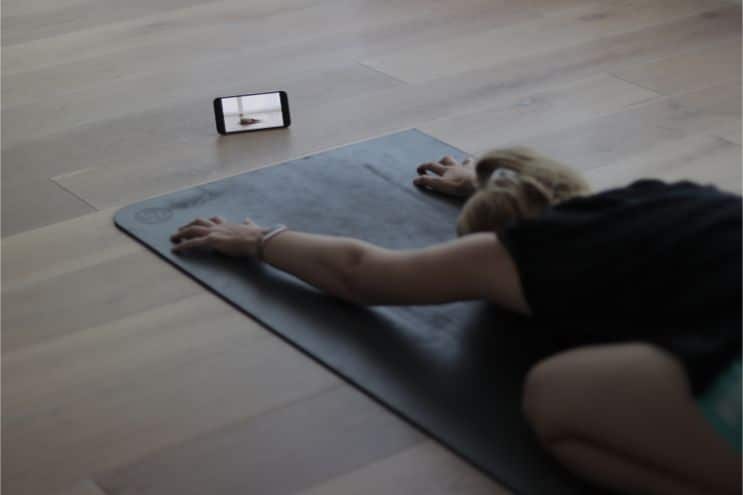
Keep your morning yoga practice simple. Photograph by TINT.
4. Don’t Question It
Did you already notice how much time you lose making decisions? Questions like: Should I practice or not? Isn’t it better to get a few minutes of extra sleep? What if I practice in the evening instead? are not helpful and there is no right or wrong anyway.
Instead, ask yourself a different question: What will the benefit of a morning yoga practice be throughout my day? If it’s hard for you to answer this question, you may find some ideas in our Magazine.
Of course, if you’re absolutely exhausted, an extra dose of sleep is probably exactly what you need. There’s nothing wrong with that. Note that the aim of your morning yoga sequence is to make you feel better. If it just means extra stress for you, give yourself something else you need that morning.
However, getting up and flowing through a gentle morning yoga sequence may be the most reviving start to the day you can possibly give yourself. The feelings of calmness, grounding, balance and inner peace may benefit you much more throughout the day than a few extra minutes in bed.
Get some inspiration for your morning yoga routine from Mathieu Boldron on TINT.
5. Count Down From Five
If you’re one of the persons whose mind starts to whirl around as soon as you open your eyes (or even before), you probably know the feeling of wasting minutes and minutes while your mind runs over what happened yesterday or what is on your to-do list today. And what did you achieve during this time? Nothing.
Instead of mulling over useless thoughts, let your body take the lead. Count down from five, for example, and then jump out of bed. This helps to stop procrastinating and to take action instead. By allowing your body to take the lead, you will bring your mind along for the ride.
Especially in the morning, time is precious. If you don’t want to spend time on planning a morning yoga sequence, we’ve got you covered: We’ve created a free Yoga Class Plans collection, which contains a variety of different classes for various needs and levels.
What Your Morning Yoga Sequence Could Look Like
Whether you’re a dedicated yogi yourself or a yoga teacher looking for inspiration for a possible morning yoga sequence, try Matt Giordano’s half-hour flow to wake up and feel amazing. This morning yoga practice will bring a liveliness to the mind and a vibrancy to the body. Focus on steady, even breathing throughout this practice and consciously try to bring your attention to the sensations of your body.
1. Wake up in Child’s Pose
Start in Child’s pose and start to bring your awareness on your inhale and exhale. If you’re familiar with ujjayi breathing, establish this breathing pattern. It basically is a gentle whispering produced by slightly contracting the back of the throat, similar to a light snoring.
Hearing your breath makes it easier to connect to it and enables you to control and slow it down. It may also be helpful to count to four on every inhale and exhale. Observe the sensations of your body and how your breath is moving into, and out of, your ribcage.
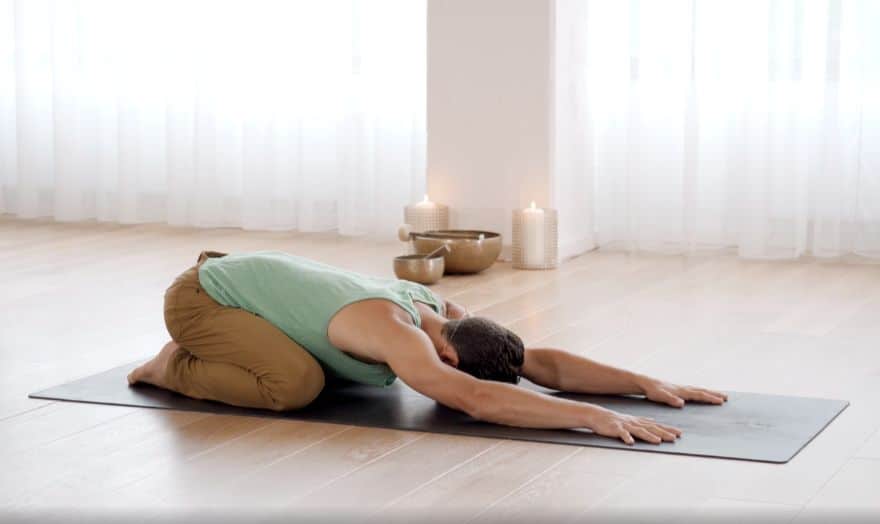
Start your morning yoga sequence in Child’s pose with Matt Giordano’s Wake Up & Feel Amazing.
2. Awaken Your Spine
Start to wake up by spreading your fingers wide and gripping them into the ground. Straighten the arms and lift the shoulders and armpits up away from the ground to activate your back muscles.
With this energy in the arms, come forward into a table-top position. Arch the spine and tuck the toes as you inhale, and with your exhale, move right back into Child’s pose. Repeat this a few times and keep focusing on your breath.
As a next step, bring the feet mat-width apart and lift your buttocks up for Downward-Facing Dog with a wide stance. Start to bend the knees and move the hips from side to side. With the feet wide, squeeze the shins towards each other to activate your inner thighs.
Transition into Plank pose and take a breath here. On the next exhale, place the knees down again and return to Child’s pose. Repeat this little sequence a few times as well and end in Downward-Facing Dog.
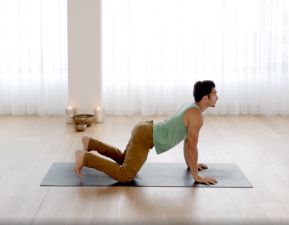
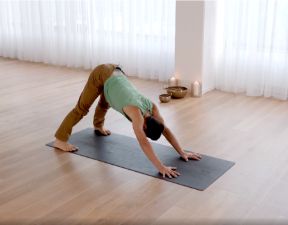
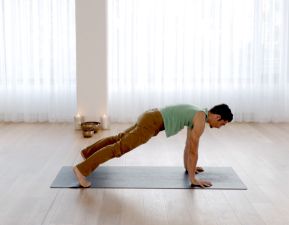
1. Arch your back. 2. Lift up into Downward-Facing Dog. 3. Transition into Plank pose. Repeat a few times.
3. Awaken Your Hips
From Downward-Facing Dog, raise the right leg up. Bend the right knee to open up your hip as you exhale. Begin to roll the right ankle joint around and, as a next step, roll the hip joint to move your knee in big circles.
Straighten the leg again and square the hip. Step the right foot forward and come up onto your fingertips. To gain some strength and tone your muscles, pull your right foot and left foot diagonally towards each other and lift the hips slightly up.
Lengthen through the head like a turtle that comes out of its shell and take a full breath before you return to Downward-Facing Dog. Come forward into Plank pose and bring your knees down for Child’s pose. Repeat the same sequence on the left side, ending in Child’s pose.
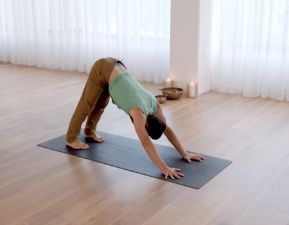
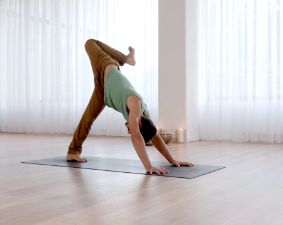
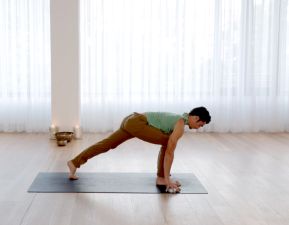
From Downward-Facing dog, lift one leg and open your hip. Draw circles with the leg before you step it between your hands.
4. Salute the Sun Gently
Further awaken the body with a few rounds of Half Sun Salutations. From Child’s pose, lift the buttocks up again into Downward-Facing Dog and slowly walk the feet to the front of your yoga mat to arrive in a Forward Fold (Uttanasana). Clasp your hands behind your back and straighten your arms to open your chest. Lift your torso up to standing and reach the arms up for Urdhva Hastasana.
Prepare for Chair pose (Utkatasana) by lifting the chest up to create a gentle backbend. From there, lift up the belly and the sides of the body, as well as the shoulders and arms and stretch up through the fingertips.
Bow down into your Forward Fold (Uttanasana). Lift halfway into Ardha Uttanasana before you come back down into your Forward Fold again. Note that you can always bend your knees or place blocks underneath your hands.
Bend the knees to come into Chair pose again and place the hands onto the thighs. Lift your chest up and reach the arms up for Urdhva Hastasana.
Do a few rounds of these Half Sun Salutations to build some heat in the body.
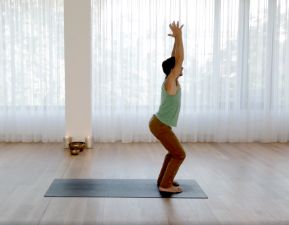
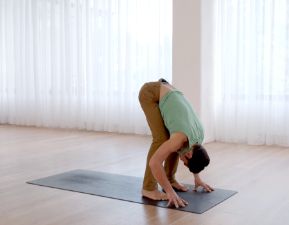
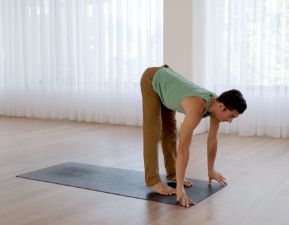
1. Bow Down into a Forward Fold. 2. Lift up into Chair pose. 3. Bow down again and lift halfway.
5. Be a Warrior
Arrive in Ardha Uttanasana (Half Foward Fold) and step the left foot back. Lift the abdomen and the sides of the waistline and reach the arms up for High Lunge. Try to grow a little bit taller by stretching from the back leg up through the fingertips. Then, bring the hands down to the ground again and step forward. Repeat this on the opposite side and end in Uttanasana and rise up to standing through Utkatasana.
Repeat this sequence again, but this time, as you step the left foot back into your High-Lunge position, open up into Warrior 2 (Virabhadrasana 2). Adjust your stance so that your front heel is in line with the middle of the back arch. Reach through your fingertips and maintain this pose for a couple of breaths.
Flip the palms and lean back into Reverse Warrior. Stretch the right side of the body up, turn the chest up towards the ceiling and stay here for a few breaths.
Come back into Warrior 2 and windmill the hands all the way to the ground. Pivot the back heel up and step the front foot back into Plank pose before you lower down onto your belly. Lift the chest for a low Cobra pose and then shift your buttocks back into Child’s pose.
Come forward into a table-top position and arch the back before you bring the hips up to come into Downward-Facing Dog.
From here, take the right leg up and bend the knee to open the hip. Then straighten the leg again to square the hip and step the right foot forward. Repeat the Warrior 2 flow on the other side before you step forward into Uttanasana and include another Half Sun Salutation.
Repeat the entire sequence, starting off with the right foot this time. After that, you can even repeat this little flow by alternating between both sides as often as you want. Return to standing at the end of this flow and pause for a few breaths to tune into your body.
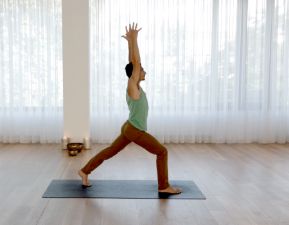
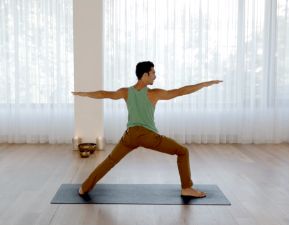
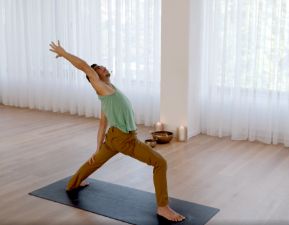
From a High-Lunge position, transition into Warrior 2 and Reverse Warrior. Repeat this a few times.
6. Release Tension
After last round of Half Sun Salutations, step back into Downward-Facing Dog, reach the right leg up and place your right shin across the mat for Pigeon pose. Place the elbows on the ground, bow the head down and take a few breaths to observe the sensation of your breath moving through your body and feel the gentle heat that might be pulsing through you.
Walk the hands towards your body and back step back into Downward-Facing Dog. Take a few breaths here before you come into Pigeon pose on the left side.
Return to Downward-Facing Dog, shift to Plank pose and lower down all the way onto your belly to roll onto your back.
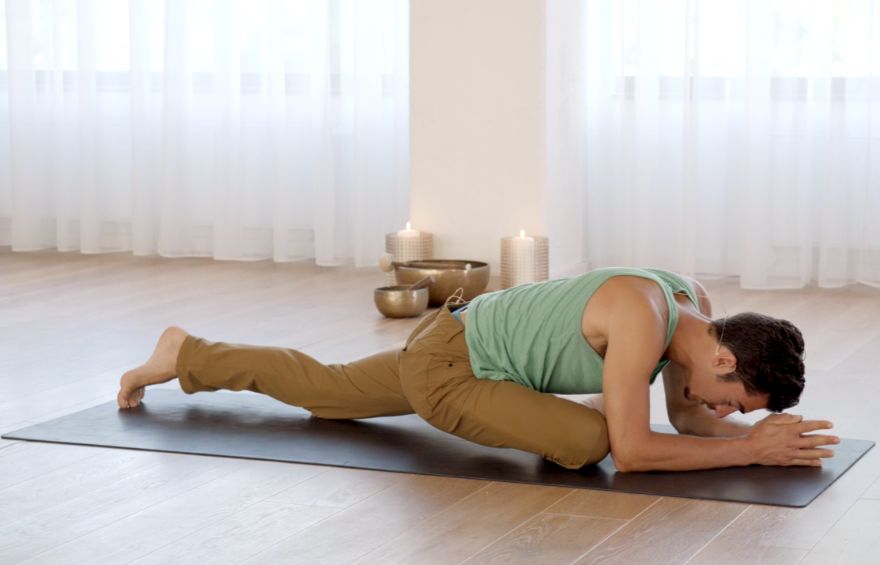
Release tension in your morning yoga sequence in Pigeon pose.
7. Relax
From here, hug your knees into your chest and rock a little bit from side to side before you stretch the legs out and let palms face up for your final relaxation (Savasana).
Observe the gentle pulse of the heart and allow your body to settle into the ground, letting the muscles relax. Take as much time as you want in Savasana.
To finish your morning yoga sequence, begin to awaken the fingers and toes. You may even want to stretch the arms overhead and roll onto your favorite side before you come up into a seated position.
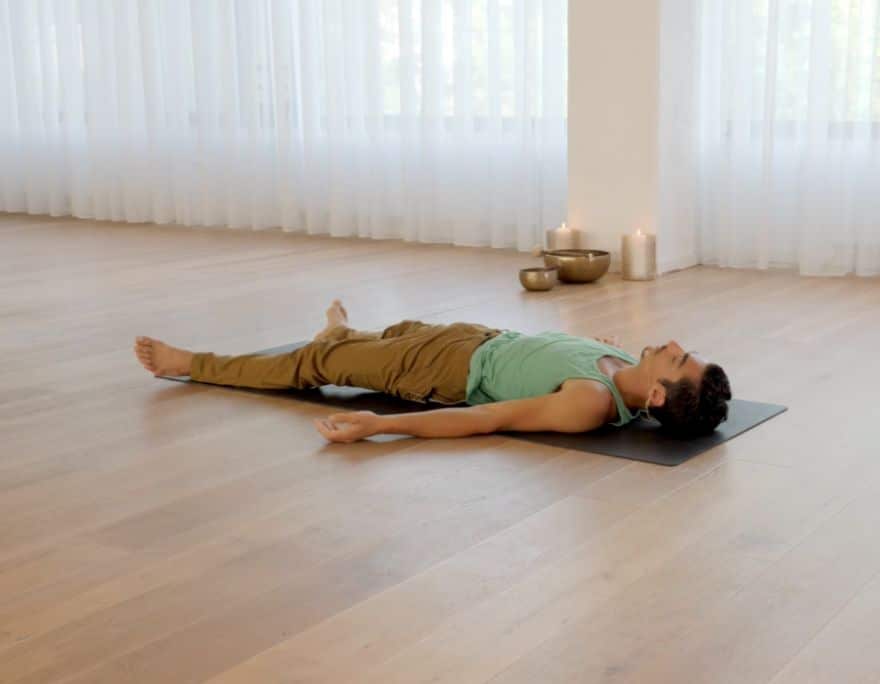
Relax in Savasana after your morning yoga sequence.
Watch the Video: Wake Up & Feel Amazing with Matt Giordano
Allow yourself to take a moment to feel the experience of being alive in your body and feeling the benefits of your morning yoga sequence. You can even extend your practice with a few breathing exercises (Pranayama) or a meditation to start your day even more refreshed and relaxed.
Get more inspiration for a morning yoga sequence on TINT.
If you’re looking for other great tools to make the most of your morning yoga practice, check out our ebook on yoga alignment secrets, which will give you a basic understanding of some of the most essential yoga alignment principles so you can use it as a quick reference guide.





